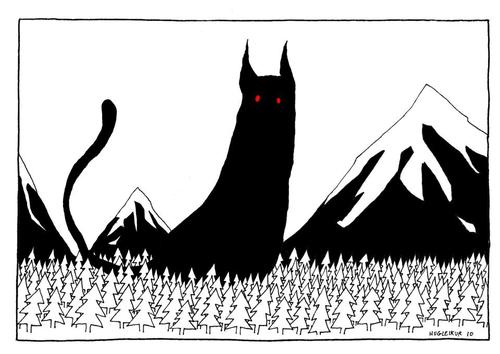"There is a charming old bit of folklore from the land of ice and volcanoes about a giant cat that, come Christmas time, will eat anyone who does not possess a new article of clothing. In short, work hard and you will be able to have something new. That speaks directly to the work ethic of Iceland’s population who garner more overtime than any other European nation.
"Though no one knows exactly how long the Yule Cat, or Jólakötturinn as he is more properly known, has been around, many folk historians believe is may go back to the dark ages. They do know that he was used as a threat by farmers to scare workers into finishing up the processing of wool from the fall season before Christmas. No doubt many Icelandic parents found the story equally useful with their children. Those that completed their work would receive new clothing as thanks. Those who didn’t were destined to be eaten.

"A variation to the story is the Yule Cat eats the food of those who do not work hard. The new clothes rule still applies as it is how he differentiates whose Christmas feast he devours. Regardless of the preference in tale told, his appetite is voracious and he does not discriminate. Still, at the very root of the myth is the time tested adage you get out what you put in. ....
"...[The story of ] when captured in the poetic lines of Jóhannes úr Kötlum in his poem that bears the same name as the tyrannical kitty ....[gave] resurgence to the myth. Icelandic superstar Björk even released a song based on the lyrics."
The author Jóhannes úr Kötlum is also called Jóhannes Bjarni Jónasson, and this Icelandic poet was written up in Encyclopedia Britannica.
Jóhannes Bjarni Jónasson (November 4, 1899 to April 27, 1972):
"[was also a] reformer whose works reflect his resistance to the political and economic trends that he perceived as threatening Iceland’s traditional democracy.
"The son of a poor farmer, Jónasson studied at Reykjavík Teacher’s Training College and worked first as a peripatetic rural teacher and later as a teacher in Reykjavík until he retired to the country as a full-time writer.
"Jónasson’s poetic development mirrors the major literary and social trends in 20th-century Iceland. His early works, in the collections Bí bí og blaka (1926; “Sleep, Baby, Sleep”) and Álftirnar kvaka (1929; “The Swans Are Singing”), are Neoromantic and lyrical in form and express a love of nature. Neoromanticism gave way to socialism in the 1930s, however, as a result of the Depression in Iceland, and his third book of poetry, Ég læt sem ég sofi (1932; “I Pretend to Sleep”), reflects this change. The poem “Frelsi” (“Freedom”) was featured in the first volume of Raudir pennar (1935; “Red Pens”), a socialist literary periodical of the time.
"The mood and style of Jónasson’s poetry underwent another change with the volume Sjödægra(1955; “Seven Days”), written not in traditional verse form but experimenting with modernistic imagery. The bitter collection Óljód (1962; “Anti-Poems”) dissonantly attacked the resignation and apathy of the welfare society, while Jónasson’s last book, Ný og nid (1970; “Waxing Moon and Waning Moon”), voiced the hope that Iceland’s new generation would continue the struggle to overcome the ideological confusion that had prevailed, in his view, ever since the conclusion of World War II.
"After the war, Jónasson also published four novels, but his prose never reached the formal and political level of his poetry. In 1948, as “Anonymous,” he published Annarlegar tungur (“Strange Tongues”), which included translations of modern poets such as T.S. Eliot and E.E. Cummings. His authorship was not revealed until the late 1950s."
It is comforting to know that the giant paw prints of T. S. Eliot are found in Iceland.
No comments:
Post a Comment